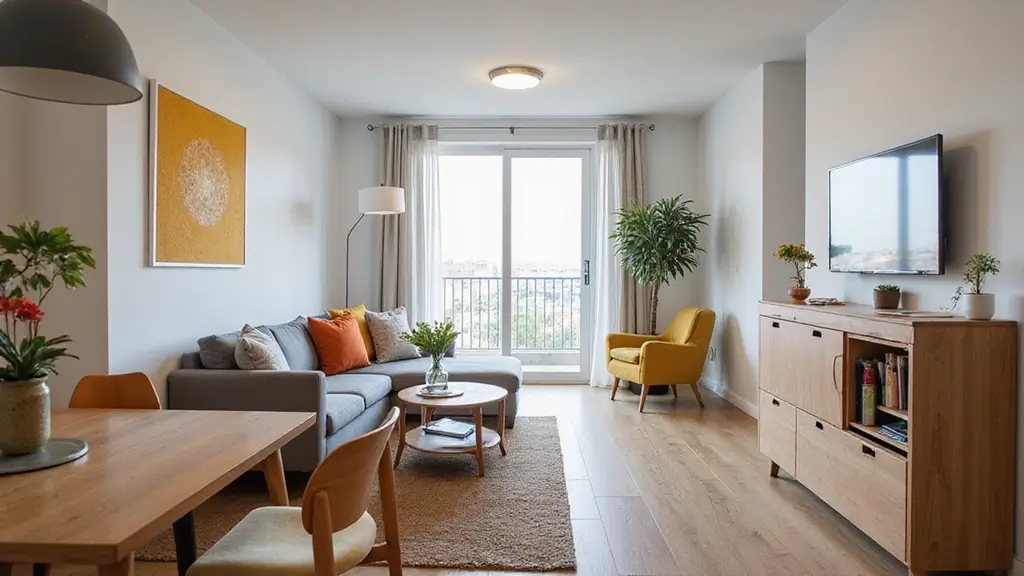I put this together because two-bedroom apartments can feel crowded fast. The right setup makes a small space feel open, comfy, and stylish. Picture sunlight on a pale wall, a soft rug beneath your feet, and furniture that fits without crowding.
Here is why this matters. If you live in a two-bedroom home and want a calmer space that still looks good, this post is for you. You care about clean lines, practical storage, and rooms you can walk through without tripping over clutter.
What you’ll get. I pulled together 30 ideas that help rooms breathe. They cover layout, color, lighting, storage, and furniture that fit a two-bedroom plan. Each idea is simple to test and easy to adapt to your space.
You’ll see tricks to define zones in open living areas, pieces that do double duty, and ways to keep traffic smooth. Learn to use vertical storage, light colors to make ceilings feel higher, and mirrors to brighten corners. I include practical examples you can borrow from your own place.
How to start is easy. Do a quick room check first. Measure doors, windows, and corners. Tape out zones on the floor to see how people will move. Pick a few changes you can finish this weekend, like swapping a heavy coffee table for a slim one or adding a tall mirror.
No idea fits every unit. Some tweaks may need permission from a landlord or building manager. Still, most ideas are quick wins that make a two-bedroom home feel more spacious and stylish.
Ready to start? Let’s dive in and make your two-bedroom feel bigger and more you.
1. Open Layout Living
You want a sense of space in a small two bedroom. An open layout ties the living room, dining area, and kitchen into one flowing area. You gain light and easy movement. You can chat with guests while you cook. And the space tends to feel bigger. Here is why open layout living helps small homes.
– Use low-profile furniture that stays near the floor. Long sight lines make rooms feel spacious.
– Define zones with area rugs. A rug under the sofa marks the living area; another under the table marks dining.
– Choose shelving or side tables that hold items but don’t crowd the view. Dual purpose pieces cut clutter.
– Light your space well. Add warm lamps and keep window coverings light to let in sun.
– Stick to a simple color palette. Two or three colors woven through walls, fabrics, and furniture keep the look unified.
– Include glass or acrylic pieces. They disappear visually and give air to the room.
– Hang mirrors to bounce light into corners and widen the feel.
Next steps: try one change at a time. Move the sofa away from the wall a few inches to improve flow. Keep walkways clear and you’ll enjoy a calm, open feel.
An open layout can make your 2 bedroom apartment feel like a spacious retreat! Embrace low-profile furniture and area rugs to define spaces and keep the vibe flowing.
2. Multifunctional Furniture
Facing a small space can feel tough. You want style and room to move. Multifunctional furniture makes this possible. It does two jobs in one piece and keeps floors clear.
– Sofa that folds into a bed gives guests a comfy place to sleep without stealing daytime space.
– Storage ottomans hide blankets, toys, or remotes and still look tidy.
– Extendable tables add room for meals or games and shrink back when you’re alone.
Why this works: you move fewer things, so the room stays neat. When you shop, pick pieces that match your style and hold up to daily use. Go for lightweight frames so you can reconfigure rooms without heavy lifting. Choose fabrics that are easy to clean and finishes that won’t scratch easily. Materials like wood, metal, and simple upholstery fit many looks.
Materials and style matter. Neutral colors help a space feel bigger. A quiet finish keeps the room calm rather than loud. Mix and match pieces that can be moved around for daily living and for hosting friends.
Next steps: measure your space, check doorways, and try the moving parts in person. Start with one versatile piece, then add a hidden-storage piece or a wall-fold desk to create a small work zone. With careful choices, your apartment will feel wider and more inviting.
3. Creative Use of Vertical Space
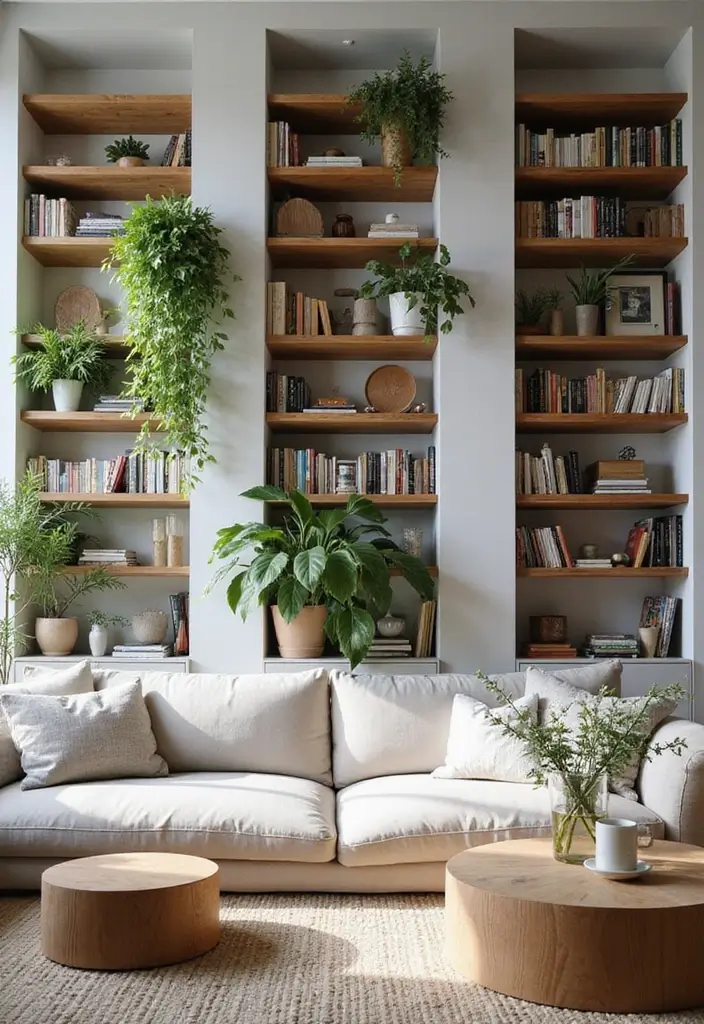
If your 2 bedroom apartment feels tight, here is how to make it feel airier. Use height to add room for living and storage. When you draw the eye upward, ceilings look higher and the space breathes.
Here is why vertical design helps. It gives you places to put things without crowding the floor. It also adds style that you can see from every corner.
– Floating shelves. Install shelves high on the wall to hold books, plants, and small decor. They keep surfaces clear in the living room and bedrooms. Simple wood or metal finishes work well with many styles.
– Tall plants or artwork. Pick slender, tall plants or vertical art pieces. They lift the room visually and add life without taking up floor space. Choose pots or frames that match your color scheme.
– Ladder shelf. A ladder shelf fits in a corner and adds multiple shelves. It brings a chic touch and extra storage without crowding the floor.
– Wall-mounted desk. A desk that folds flat against the wall gives you a work spot when you need it, and hides away after. It keeps a small living area clean.
– Vertical storage behind doors. Hooks, slim organizers, or pocket organizers on doors use unused space. It frees dresser and closet space for clothes and essentials.
Next steps. Start with one wall and a small shelf set. Keep colors light and textures airy. Use wood, metal, or woven accents to match your vibe. You’ll feel more room to move and relax.
4. Use of Light Colors
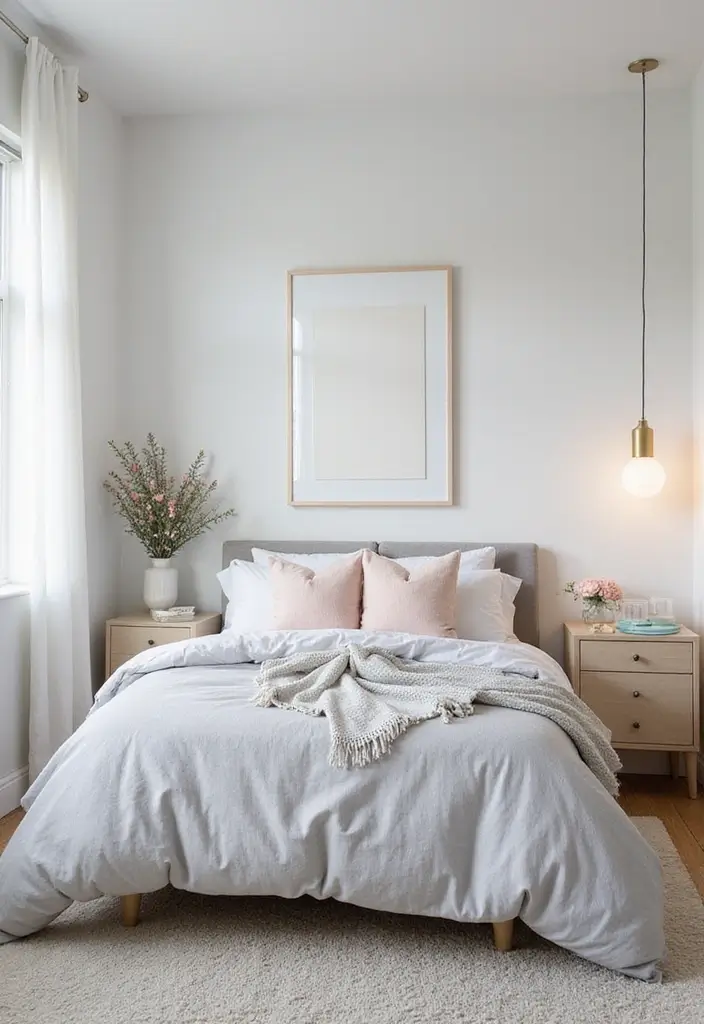
If you want a room that feels bigger, start with a light color plan. Light colors bounce sunlight and make a space feel airy. Soft whites, pastels, and pale grays reflect light rather than soaking it up. This helps walls, furniture, and décor stay visually tied together.
You can use light hues on walls, sofas, and bedding. Keep a pale base and add life with art or textiles in small color pops.
Here is why it works. Light tones keep the eye moving through the room. They also pair well with natural light, so mornings feel sunny and evenings feel calm.
Tips:
– Pick high-gloss or satin finishes on walls or ceilings to boost light reflection.
– Choose sheer or light-colored drapes that let daylight pour in.
– Use light flooring or a light rug to extend the look across the floor.
– Bring in texture and warmth with wood, linen, or jute to avoid a sterile feel.
– Add an accent color through a few featured pieces like art or a throw.
Next steps. Start by choosing a color family you like and test swatches in natural light before you commit. This approach makes rooms feel brighter and more welcoming.
5. Stylish Room Dividers
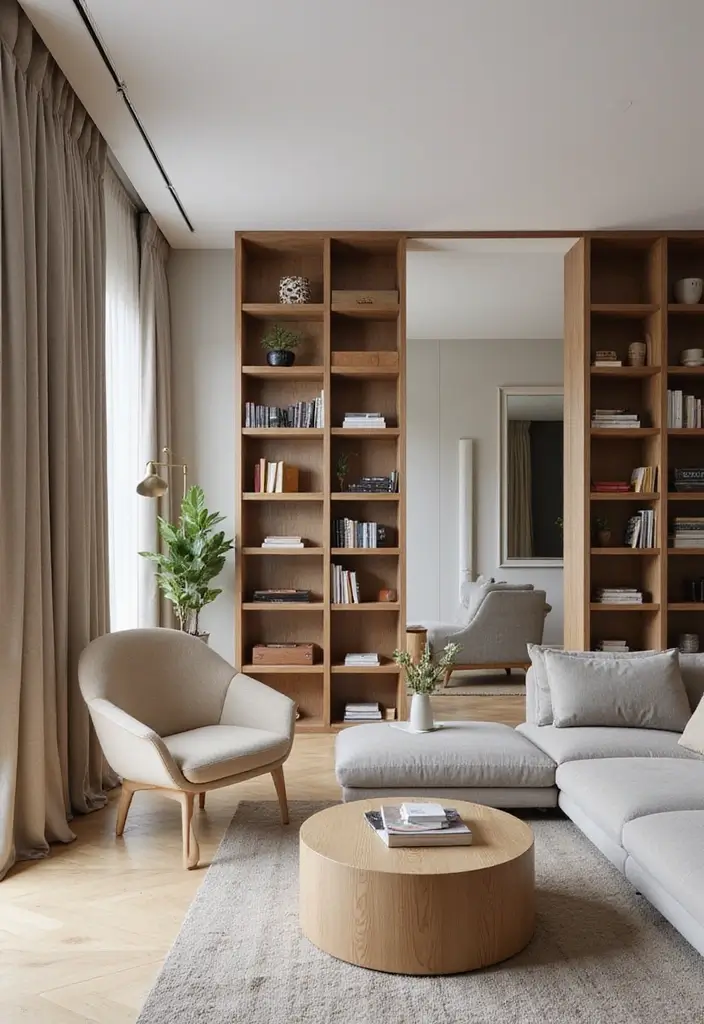
In a 2-bedroom apartment, you want zones that feel open. Room dividers can do this. They separate living and sleeping areas without closing the space. You gain flow and style.
Here is why it helps: light stays easy, and you add storage or display.
Try these options.
– Open shelving as a divider
A shelf wall creates a soft boundary. It lets light pass and gives you spots for books and plants. Choose a shallow unit and paint it to match your decor theme. Keep the top clear so you can see through.
– Curtains that flex
Curtains soften the space and can close a zone for privacy. Use a light fabric so sunlight slips in. Install a ceiling track or rod, and use ties to open the space.
– Plants that divide a space
Tall plants act as living screens. Pick pots that fit your color scheme. Place them along a line to carve a path or by the sofa to shape the room.
– Freestanding screens and panels
Wood, fabric, or bamboo screens add texture. They are light and move easily. Put them where you want a quick break, then move them aside for guests.
– Movable dividers on wheels
Wheeled screens give real flexibility. Slide them to form a dining nook or open the room. Pick lightweight styles so you can shift with one hand.
Next steps: measure space, pick one idea, and test it this weekend.
In a 2-bedroom apartment, style meets function with smart room dividers. They create flow, let in light, and add personality – turning separation into inspiration!
6. Layered Lighting

If your small 2 bedroom feels cramped at night, lighting helps. Layered lighting uses three kinds of light at once: ambient, task, and accent. Ambient fills the room with even brightness. Task light shines where you cook, read, or work. Accent light highlights art, textures, or shelves. Mix them and space feels deeper and more inviting.
Here is how to set it up. Start with ambient lighting. A ceiling fixture or wall sconces gives broad brightness. Add task lights where you need focus: a floor lamp beside your chair, a desk lamp, or under-cabinet lights in the kitchen. Then add accent lighting to create mood and depth. String lights on a shelf, a tiny spotlight on a favorite picture, or a row of LEDs under a ledge.
Tips:
– Use dimmer switches so you can soften or raise the glow.
– Include multiple light sources in each room to avoid shadows.
– Pick a bold light fixture as a room focal point.
Warm up with warm white bulbs, 2700K to 3000K. Keep cords tidy and place lights to guide the eye through the space. Layered lighting makes your home feel calm and welcoming.
Next steps: test different placements, swap bulbs for warmer or cooler tones, and watch the space open up as you adjust.
7. Minimalist Decor
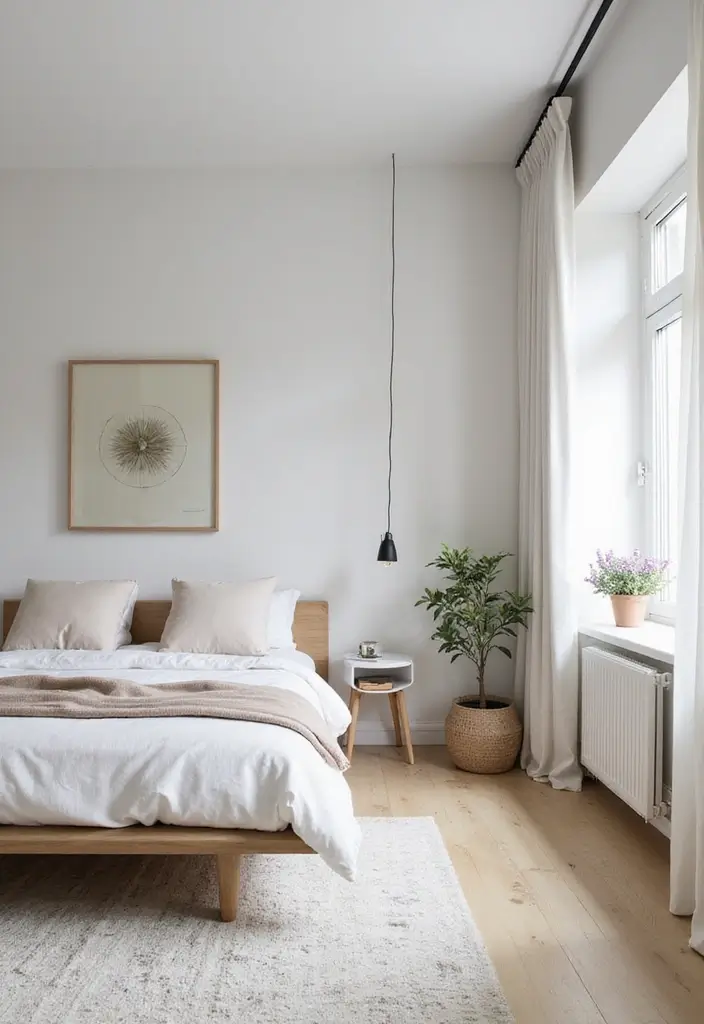
If your small apartment feels crowded, you need calm and space. Minimalist decor can give you that feel without making your home look empty. It trades clutter for clarity, and it shows off the things you love.
Here is why this style helps a compact home. It makes rooms breathe. It also makes daily life easier because less clutter means less to clean and move around.
– Limit the pieces on show. Pick a few bold items that fit your style. Let walls breathe instead of packing them with art.
– Choose furniture with clean lines. Look for shapes with straight edges and slim legs. This keeps eyes moving freely and rooms feeling open.
– Add hidden storage. Use furniture that hides stuff away. Think beds with drawers, coffee tables with storage, and wall panels that hide cords.
– Keep a simple color palette. Start with mainly neutrals like white, taupe, and gray. Add warmth with wood tones, linen, or a soft rug.
– Select a few statement pieces. Two or three striking artworks or a unique lamp are enough. More items crowd the space.
– Layer lighting. Use a soft ceiling light plus a floor lamp or table lamp. Light makes rooms feel bigger.
– Mix textures to add interest. Weave in wood, fabric, and stone so the space feels cozy, not flat.
Next steps: study your rooms, pick a few key items, and give every surface a purpose. Minimalist decor can highlight your style while keeping your home airy and easy to live in.
8. Smart Storage Solutions

If your two-bedroom apartment feels tight, smart storage can make a big difference. It helps rooms stay calm and easy to move through.
Under-bed bins, over-the-door pockets, and built-in cabinets save space by keeping items out of sight. They turn unused spots into useful storage.
Choose furniture with hidden storage too. A bench with a hollow seat or a coffee table with two drawers can hold blankets, games, or electronics and still look clean.
Go vertical. Tall dressers and open shelves use the height of your walls. A wall of shelves gives you space for books, baskets, and display pieces without crowding the floor.
Practical ideas:
– Measure your rooms, then pick two spots to improve this week.
– Use decorative boxes or baskets to keep smaller items tidy.
– Rotate seasonal items so you only store what you still need.
With smart storage, your home feels lighter and more organized. Small changes can add up, and you’ll notice the difference in every room. Next steps: pick one tip today and try it.
If you have a small entry hall, try a slim console with a drawer and a narrow shelf. It gives you a landing spot for mail, keys, and gloves, keeping the rest of the house tidy.
9. Balcony or Outdoor Space Usage
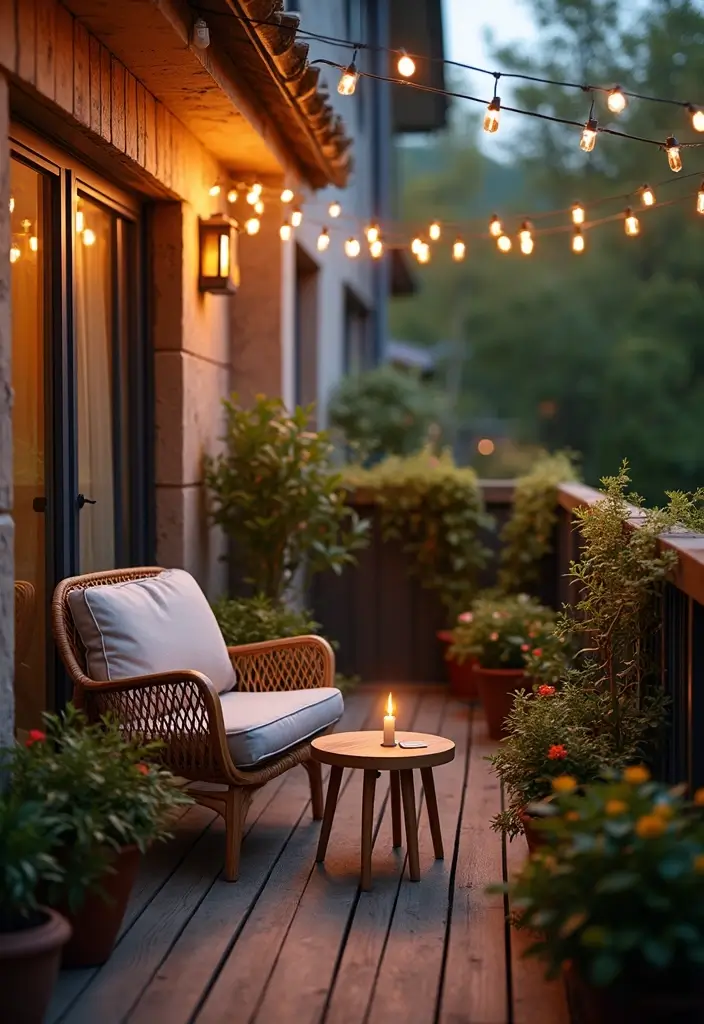
Your balcony should feel like extra living space, not a crowded corner. You want a spot you can use daily. Here is why outdoor space matters: it brings fresh air, narrows the gap between indoors and outdoors, and adds calm. It can also grow your usable area without moving walls. Now let’s break down practical steps you can take.
– Smart, compact furniture: Choose foldable chairs and a small dining set that tuck neatly away.
– Weather-ready materials: Pick aluminum, resin wicker, or teak that stand up to sun and rain.
– Dual-use planters: Use planters that double as seating or storage to save floor space.
– Outdoor rugs and textures: Add an outdoor rug for warmth and a homey feel.
– Ambient lighting: String lights and lanterns glow softly after sundown.
– Vertical greenery: Hang wall planters or railing boxes to free floor space.
– Smart storage: Keep a compact storage bench for cushions and tools.
– Safe layout: Leave clear paths and avoid crowding near doors.
Put one idea into action this week and see how it changes your evenings. Notice how easier it becomes to relax, dine, or work outside. Tweak placement based on sun, wind, and how you move through the space. Small changes, big impact.
10. Textured Accents
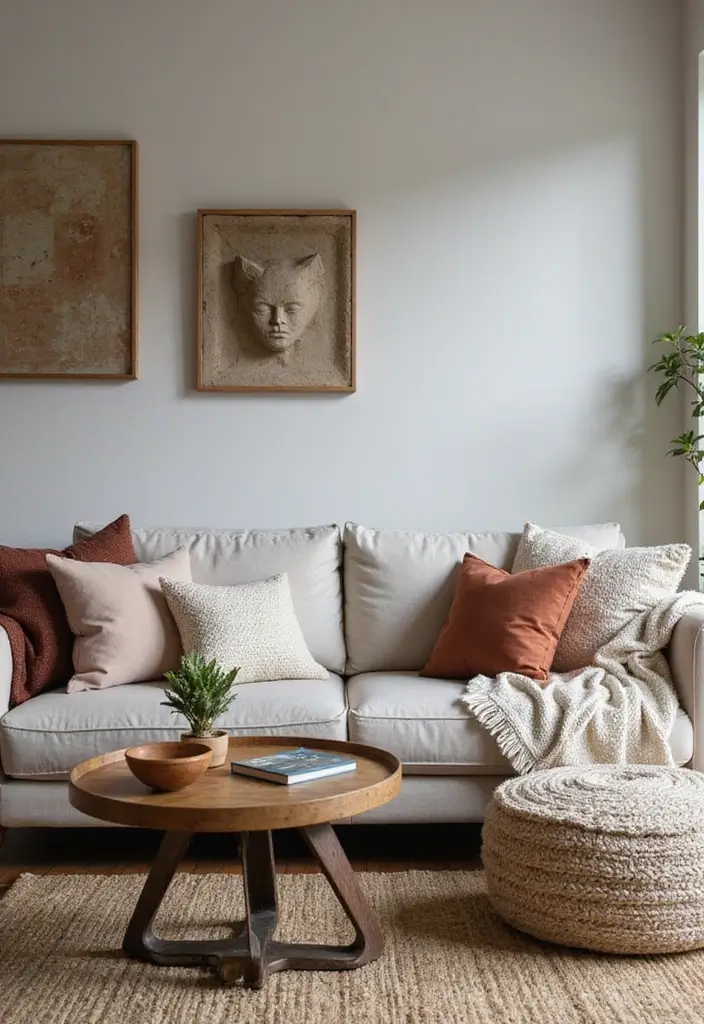
You want a two bedroom that feels bigger and warmer. Textured accents help you get there without a big overhaul.
Texture adds depth. It catches the eye and guides you through the space. Use wood, metal, and fabric to create a layered look. Throw pillows, rugs, and blankets warm the room, while metal fixtures or wood furniture add character. Mixing textures keeps your space lively and makes it feel larger.
Suggestions:
– Mix soft fabrics with sleek metals for contrast.
– Use textured wallpaper or an accent wall for depth.
– Try natural elements like bamboo or rattan for warmth.
Textured accents can be the secret ingredient to a space that feels comfortable and stylish.
Here is why texture works in a small apartment. It helps define zones in open layouts and hides small flaws. It also invites touch, making a room feel lived-in.
Next steps:
– Pick one texture as your base, such as a neutral wool rug or a woven throw.
– Add an accent wall or textured wallpaper in a calm shade to draw the eye.
– Layer textiles: a knit throw, a velvet pillow, and a jute rug create depth without crowding.
– Choose a natural-weave piece of furniture, like a rattan chair or bamboo side table, to keep things light.
Texture brings warmth and interest without clutter. Use it with care, and your two bedroom will feel welcoming and polished.
11. Statement Furniture Pieces

In small spaces, you want a focal point that doesn’t crowd the room. A statement furniture piece can do that work. Look for a bold-colored sofa, a sculptural coffee table, or a large piece of artwork that grabs the eye.
Place it where you naturally walk, not in a tight corner. Give it some space from walls so the room breathes. Let the piece guide traffic and keep sight lines clear.
Pair the bold item with quiet neighbors. Neutral chairs, a soft rug, and simple lamps keep the room balanced. The contrast makes the centerpiece stand out without shouting.
Check the size before you buy. Measure doorways first and imagine how it will sit in your space. If the room is tiny, choose a low-profile sofa or slim coffee table.
Use lighting to spotlight the focal piece. A floor lamp, a wall wash, or a gentle ceiling glow can make the centerpiece pop and let other items recede.
Tips:
– Balance the centerpiece with neutral surroundings.
– Mind the scale so the furniture fits without crowding.
– Let lighting highlight the focal point.
Next steps: pick one item, confirm measurements, and arrange seating so it feels right.
12. Customized Closets
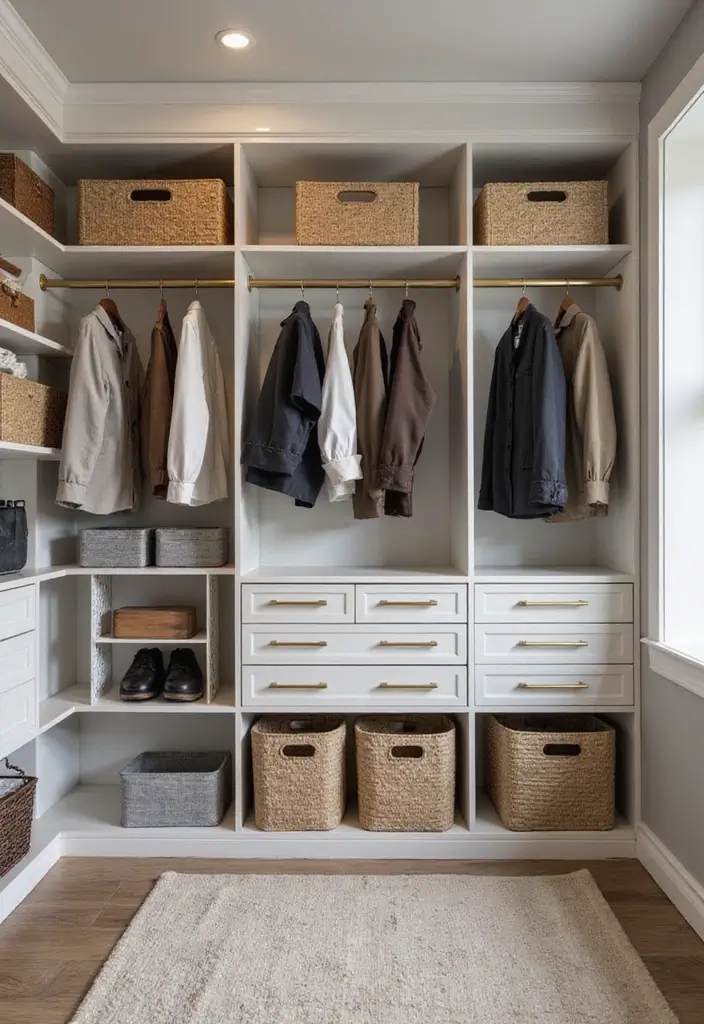
If your small apartment feels crowded, a customized closet can change that. It frees floor space and makes getting ready easy. Build a system with shelves, rods, and drawers that fit how you live. It turns a cramped corner into a calm, useful zone.
Here is why this approach helps. It keeps you organized, cuts clutter, and makes dressing feel simple.
– Choose a modular closet system. Look for shelves, rods, and drawers that snap together and can move as your needs change. Pick sturdy materials like metal rails and solid wood or melamine shelves. This lets you reconfigure when your wardrobe grows or shifts.
– Keep items visible with clear bins. Use see-through boxes and label them so you can spot what you need at a glance. Put the pieces you wear most at eye level. The system feels lighter the moment you can see everything.
– Use vertical dividers for shoes and accessories. A tall, slim shelf keeps pairs standing upright. Shoes stay tidy and easy to grab. Small items slide into labeled bins, so you don’t hunt for lost belts or scarves.
– Create a folding space for bulky items. Leave a fold-down area or a shallow bench for sweaters, towels, and linens. It gives you a simple spot to sort and fold without cramming every shelf.
With these steps, your closet becomes a neat, functional part of the room. Next steps: measure your space, pick a system, and start your tidy transformation.
13. Personal Touches
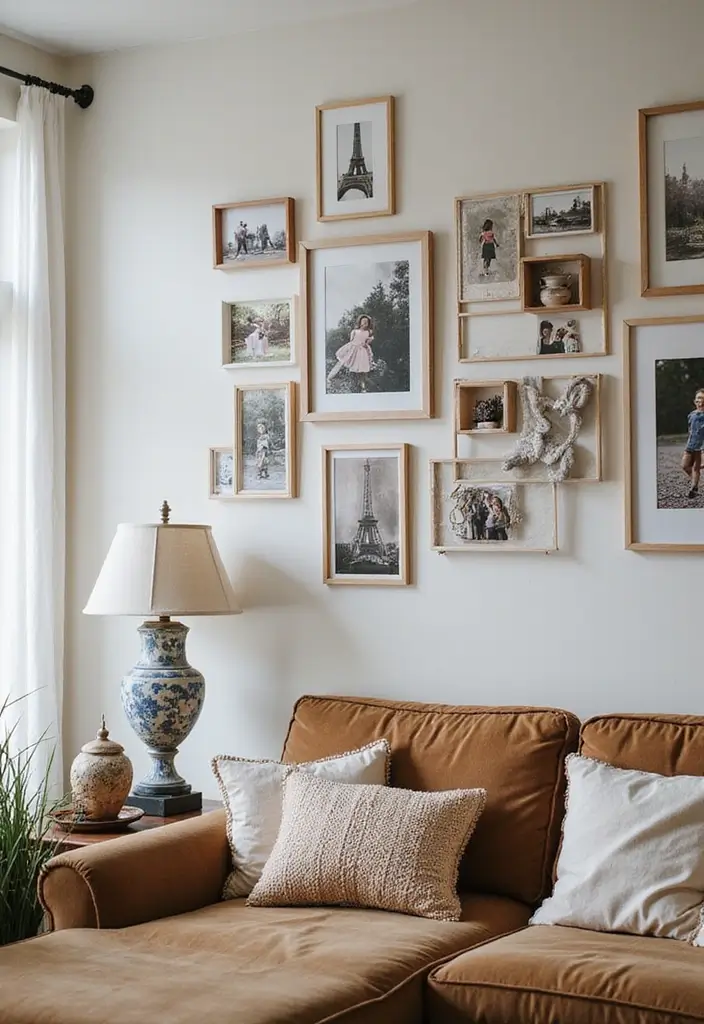
You want your apartment to feel like home while staying neat. Personal touches do that. They tell your story and invite people in. When you display them with care, they warm the room without making it feel crowded.
Here is why personal touches help.
– Gallery wall with mixed frames
Hang a row of photos, prints, and small art in different frame sizes. Vary the spacing. Keep the arrangement at eye level for easy viewing.
– Decor trays for small items
Use decorative trays to group keys, sunglasses, jewelry, and little souvenirs on a console or coffee table. Trays corral clutter and make tiny vignettes feel intentional.
– Seasonal refresh
Rotate a few pieces with the seasons. Swap in a new color accent, like a pillow or vase, and keep the rest calm. A small, consistent palette makes updates easy and stylish.
Choose items that feel meaningful. Family photos, travel keepsakes, and handmade art all work. Let space breathe by mixing large punchy pieces with quiet ones. Add texture with a plant, a woven throw, or a wood frame.
Next steps: start with one wall or one shelf. Pick 3-5 pieces. Use a tray nearby to keep the look tidy. You’ll create a space that feels like you—without losing room to move.
14. Outdoor-Inspired Decor

Bringing elements of nature into your apartment can greatly elevate your decor. Consider using botanical prints, natural wood finishes, and earthy colors to create an organic feel. Houseplants are excellent additions for improving air quality and adding life to your environment. This approach connects the indoor space to the outdoor world, making it feel more expansive and refreshing.
Suggestions:
– Use large plants as focal points in corners.
– Incorporate natural materials like jute rugs or bamboo furniture.
– Opt for nature-inspired artwork to enhance the theme.
Outdoor-inspired decor will create a serene atmosphere throughout your apartment.
15. Functional Entryway Design
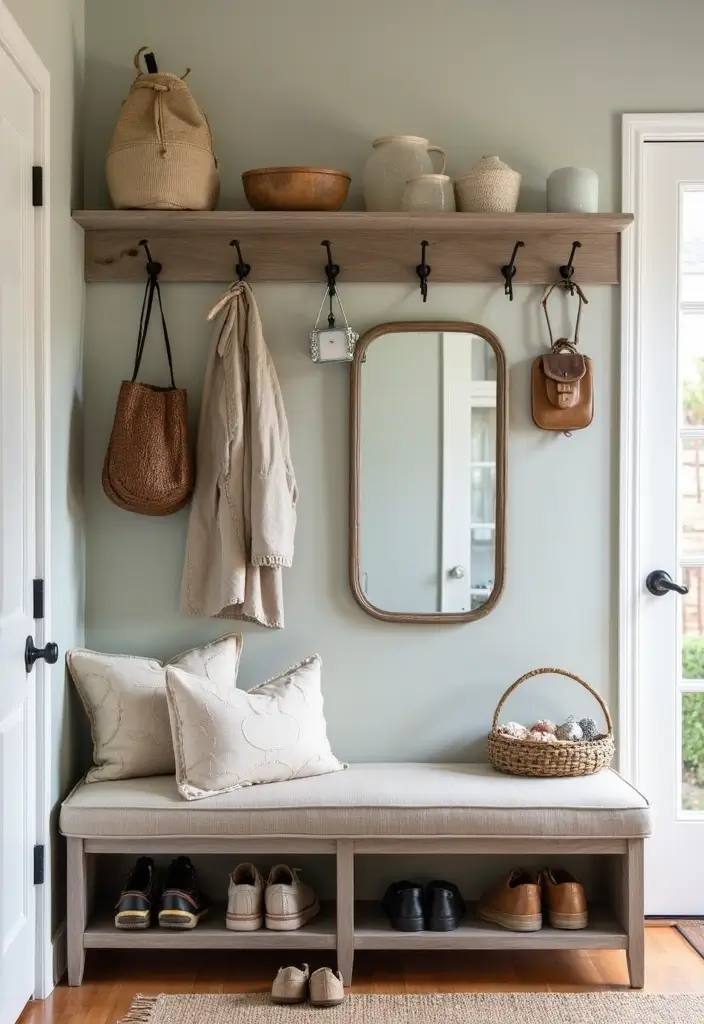
Your entryway is the first moment you feel at home. It must be handy and inviting, even in a small apartment. With care, this space can set a calm tone for your whole home. Here is how to make a compact entryway feel spacious and useful.
Tips:
– Choose furniture that does two jobs. A slim console with a hidden drawer, or a bench that lifts for extra storage.
– Use baskets or bins for shoes. A low rack by the door keeps pairs neat; a tall bin handles boots.
– Add a small console table for style. A vase, a candle, and a tray for keys stay tidy and simple.
A mirror on the wall helps bounce light and makes the space feel bigger. A bright, warm light loosens the chill of a closed doorway. Hooks at the door side keep coats off the floor, and a bench invites you to sit while you put on shoes.
Next steps: keep the floor clear, pick a simple rug that runs the length of the entry, and choose colors that reflect light. With clear zones for coats, shoes, and bags, you create an entry that welcomes you every day. That neat setup keeps mud off the living room and makes mornings smoother.
A well-designed entryway sets the tone for your home. With multifunctional furniture and clever storage solutions, even a small space can feel welcoming and organized!
16. Accent Walls
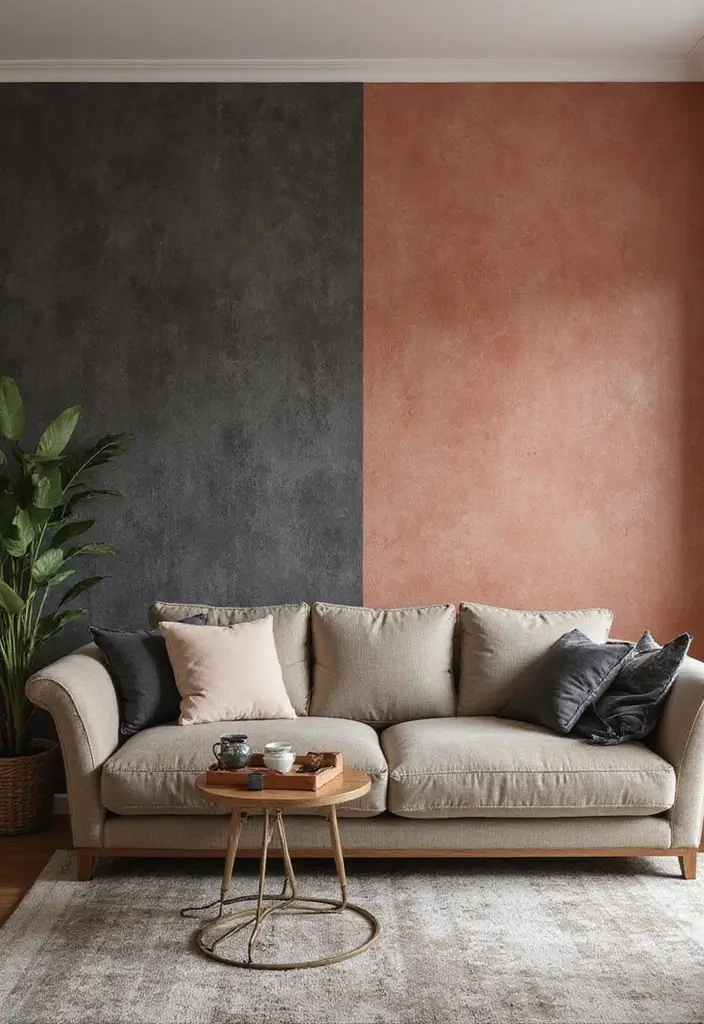
Wishing for a room that feels bigger in your two bedroom apartment? A single accent wall can do the job without a big renovation. Here is why it helps: it adds depth, guides the eye, and makes zones in a room feel clearer.
Here is how to pick the wall:
– Choose a wall that naturally draws the eye, like the one behind a sofa or at the end of a short hallway.
– Skip walls that hide behind doors or get little natural light.
– Test color or pattern with swatches before you commit.
Finish options you can try:
– Paint a bold panel: paint just a portion of the wall in a shade several steps different from the rest of the room.
– Removable wallpaper: great for renters and easy to switch with the seasons.
– Wood paneling or shiplap: adds warmth and texture without closing in the space.
Practical tips to pull it off:
– Keep the rest of the room simple. Let the wall do the talking.
– Add a small shelf, a piece of art, or a mirror that echoes the wall color.
– Use lighting to highlight the wall. A wall sconce or a track light can draw attention nicely.
Common pitfalls to avoid:
– Going too dark in a small room can make it feel closed in.
– Choosing a texture that clashes with furniture or textiles.
– Forgetting to test changes in both day and night light.
Next steps: measure the wall, pick your finish, and try a test patch. If you like what you see, install it and enjoy the refreshed space.
17. Cozy Reading Nooks
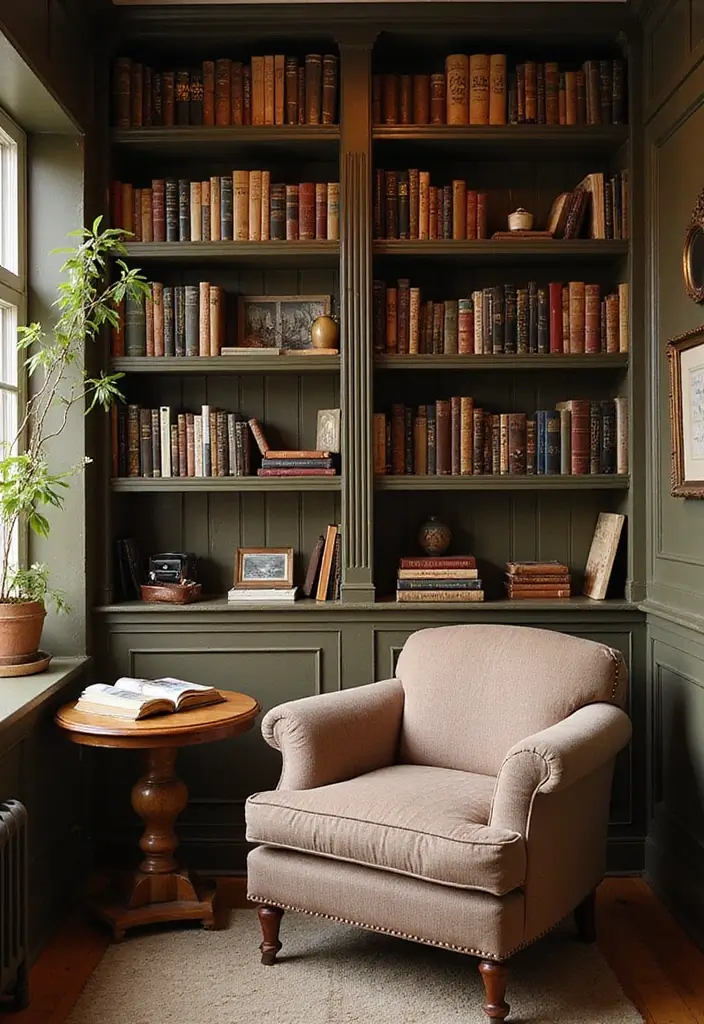
Looking for a small corner that invites you to read? A cozy reading nook can fit any apartment. Pick a quiet spot in your living room or bedroom. Add a compact chair that fits the space. Put a slim side table nearby for a drink. Include a focused reading lamp. Place a tidy bookshelf within reach for your next page. Soft throws and a couple cushions turn the chair into a true nest you want to use every day.
Here is why it works. A dedicated spot helps you slow down, relax, and focus on a book. It also adds warmth and charm without stealing space.
Tips:
– Choose a compact chair that fits your corner.
– Keep a slim bookshelf within arm’s reach for current reads.
– Use a warm, dimmable lamp to ease eye strain.
– Drape a soft throw and a couple cushions to make a nest.
– Personalize with a framed photo, a small plant, or favorite book covers.
– Keep the space tidy and well lit for easy reading.
A cozy reading nook adds comfort and practicality to your small home.
18. Smart Use of Rugs
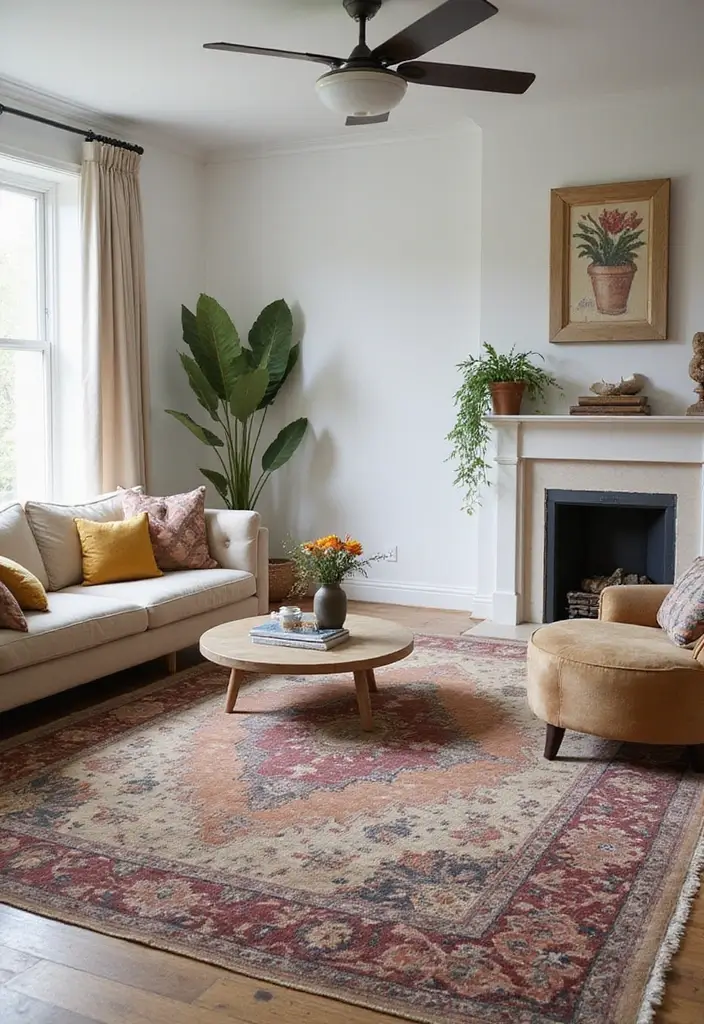
If your apartment feels flat or crowded, a rug can fix that fast. It adds warmth, texture, and a sense that the space belongs to you.
Three smart rug strategies
– Use a large rug to anchor a seating area, letting furniture sit partly on the rug so the room reads as one warm, connected space.
– Layer rugs for depth by placing a smaller patterned rug over a neutral base, which adds texture without shouting.
– Use rugs to carve open layouts by placing different textures in dining and work zones to signal each space and keep traffic clear.
Materials and colors to love
– Aim for natural fibers like wool, jute, or cotton. They feel good underfoot and wear well.
– Wool stays soft and durable in daily life.
– Jute brings warmth with an earthy vibe, great for casual rooms.
– Choose colors that fit your palette and patterns that echo other accents without clashing.
Safety and upkeep
– Add a non-slip pad under every rug to prevent slips.
– Clean spills quickly with a damp cloth and a little soap.
– Vacuum weekly and rotate rugs to even wear.
– A tidy rug stays comfy and fresh longer.
Next steps: measure your room from wall to wall, sketch where furniture sits, and pick one statement rug to start. Then add a lighter layer or a runner to guide foot traffic and tie rooms together.
19. Wall-mounted Desks
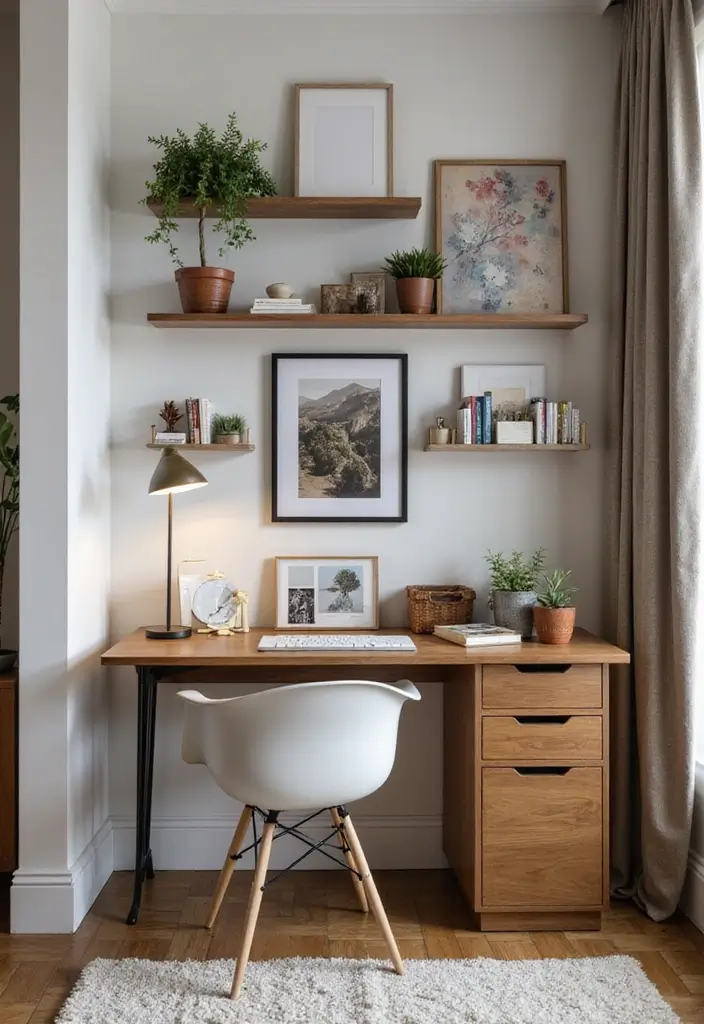
If you live in a small apartment, you need a real workspace without losing floor room. A wall-mounted desk can give you that. It folds down when you work and folds up when you are not using it.
These desks stay slim yet offer options. You can pick wood, white laminate, or metal finishes. Some models come with shelves, cubbies, or cable trays. You get a sturdy surface for a laptop, notebook, and charger, plus space for a pen and cards. The look can be sleek and modern or cozy and warm to match your style.
Here is how to make it work in your home.
– Choose a unit with built-in storage features. Look for small drawers, shelves, or cable holes.
– Plan the layout around lighting. Add a lamp or clamp light so you can see clearly.
– Find the right height. Mount the desk at elbow level when you sit.
– Think about durability. Pick materials that can take daily use.
– Finish with smart decor. Keep the area tidy with a tray and a plant.
This setup works with laptops, tablets, and notebooks. Many people place them near a window to enjoy daylight. Wall-mounted desks create workspaces in small apartments.
20. Bright and Airy Textiles
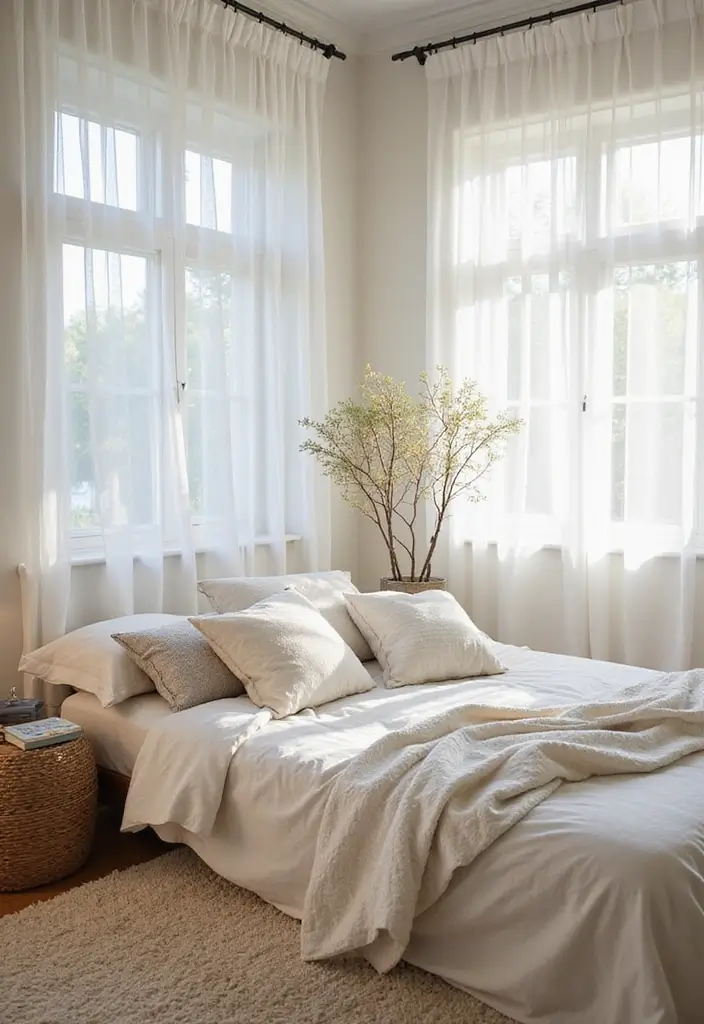
Feeling the need for a space that looks bigger and lighter? Bright and airy textiles can do that magic. Start with sheer curtains that let the sun drift through, not glare you out. Choose bed sheets and throws in lightweight fabrics like cotton, linen, or airy blends. Breathable materials keep you comfortable and add a calm, open feel. Mix patterns and textures in the same soft color family to keep things cohesive yet interesting.
Here is why
Light fabrics plus careful layering let in air and light. When sunlight moves freely, walls feel higher and rooms feel more open. Breathable textures stay comfy during warm days and cool nights. A touch of varied textures stops the space from feeling flat, while still feeling calm and organized.
Suggestions:
– Use light-colored or white fabrics for a clean look.\n\n- Layer textiles to add depth while keeping it light.\n\n- Rotate fabrics seasonally to stay comfortable, fresh, and relevant.\n\n- Mix small patterns with solid shades to keep the room balanced.
Bright and airy textiles set a refreshing tone for any room. Next steps: pick a couple of key pieces now, and plan a simple swap each season to keep the space feeling open and welcoming.
21. Vintage Meets Modern
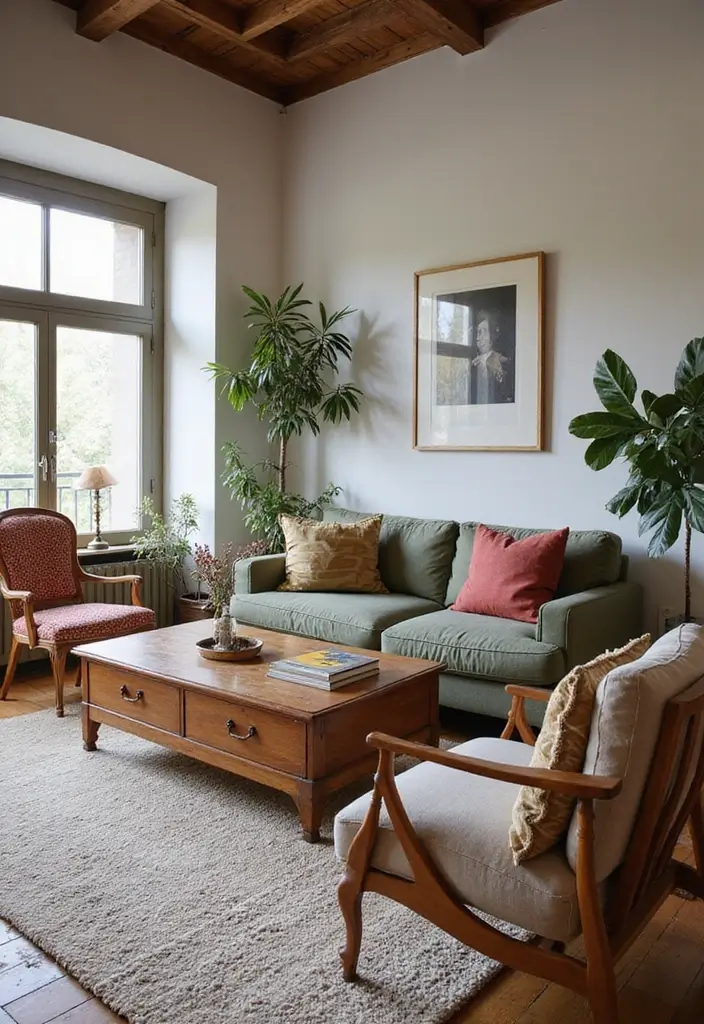
Here is why vintage pieces can make a small apartment feel bigger. They add warmth and texture that soften cold lines.
Start with one anchor piece. Look for heirloom chair, a lamp with a patina, or thrifted coffee table. Let that piece tell a story.
Next steps, mix it with modern items. Pair the vintage chair with a sofa and metal legs. Keep lines quiet. This contrast adds depth without crowding the space.
– Color balance Choose a calm palette that blends both styles. Neutrals with warm wood or black metal work well.
– Textiles Use a vintage rug or throw to unite the look. Pick fabrics that feel soft and inviting.
– Art and lighting Add a vintage lamp or art to tie room together.
Mind the scale. A heavy piece can overwhelm a room. If space is tight, pick a standout vintage item and keep the rest sleek.
Here is another tip. Don’t fear mixing eras. A mid‑century chair can sit with a modern sofa. The result feels intentional, not busy.
Next steps: plan your layout, test it with tape, and move pieces until it clicks. With care, Vintage Meets Modern makes the apartment feel spacious and personal.
22. Clever Kitchen Solutions
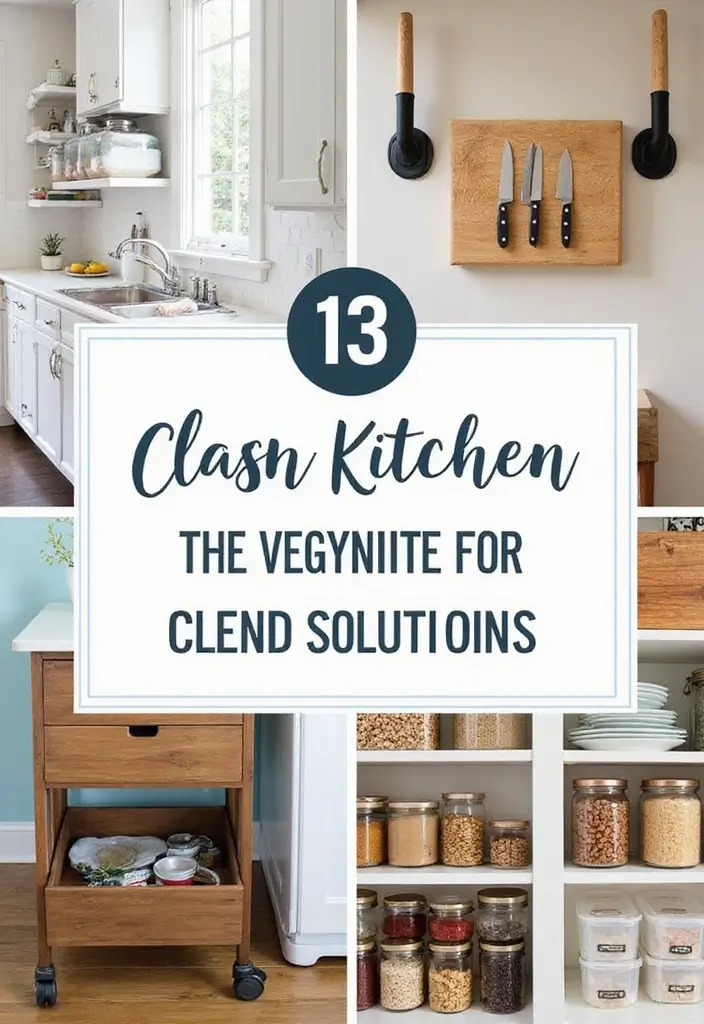
Your two-bedroom kitchen can feel tight. You need space for prep and cooking without the mess. Here is why these tricks help. They add surface, quick access, and a calm look you can enjoy.
– Rolling cart Rolling cart adds prep space and a mobile work surface. Use it to hold cutting boards, knives, or a bowl of fruit. When guests arrive, roll it out of the way.
– Magnetic knife strip A magnetic strip on the wall frees counter space and gives you quick access to knives. It adds a clean line to the room.
– Clear jars Clear glass jars turn a crowded pantry into a calm wall of order. See what you have, avoid duplicate buys, and keep lids stacked.
– Wall-mounted racks Install racks for pots and pans. They keep weight off the counters and let you see what you own.
– Foldable dining table A foldable or drop-leaf table can serve as a prep area and a small meals spot. Grab a chair, then fold it away.
– Slim pull-out shelf Add a slim pull-out shelf under the counter. It holds spices, cans, or bottles and slides cleanly back.
– Spice rails Spice rails or magnetic tins sit on the wall near the stove. Grabbing flavor quickly saves steps.
Next steps: pick one idea to try this week, then add another.
23. Mindful Use of Color
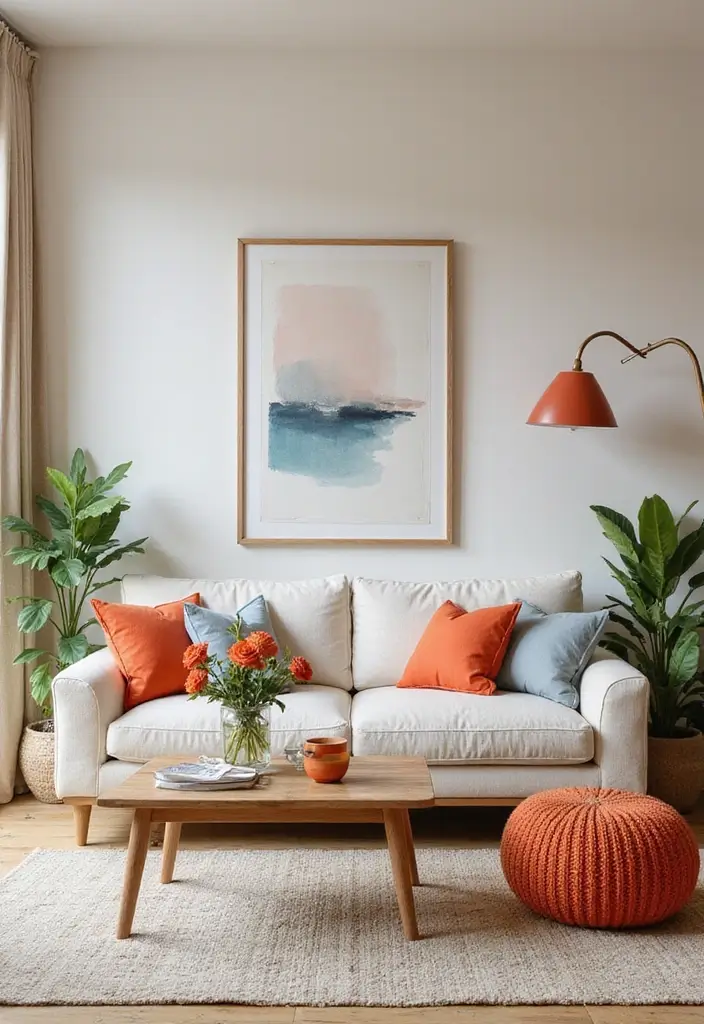
Feeling cramped in a small apartment? Color can change that. Soft neutral tones on walls and big pieces help space breathe. A calm palette defines zones without extra walls. Use bold colors only as accents to avoid crowding the eye. You can stay stylish by adding color through textiles, art, and accessories.
Here is why color works in tight rooms. Light hues reflect more light and push surfaces back. You can separate areas by color, not walls, with placement of rugs and cushions. The goal is a calm, inviting place you will want to stay in.
Tips:
– Use color to delineate areas without barriers.
– Keep larger furniture neutral and use smaller items for pops of color.
– Choose colors that match your personality but also promote calm.
Make color your ally with simple ideas. Let textiles carry the palette—curtains, cushions, and a rug in the same family. A single soft wall can anchor the room. Add a plant or a framed print for a touch of nature.
Next steps:
– Pick 2-3 soothing shades as a base.
– Test color chips in different light.
– Layer color with fabrics and art, not every surface.
– See how daylight changes the mood.
Mindful color choices can turn your tiny space into a peaceful haven.
24. Layered Window Treatments
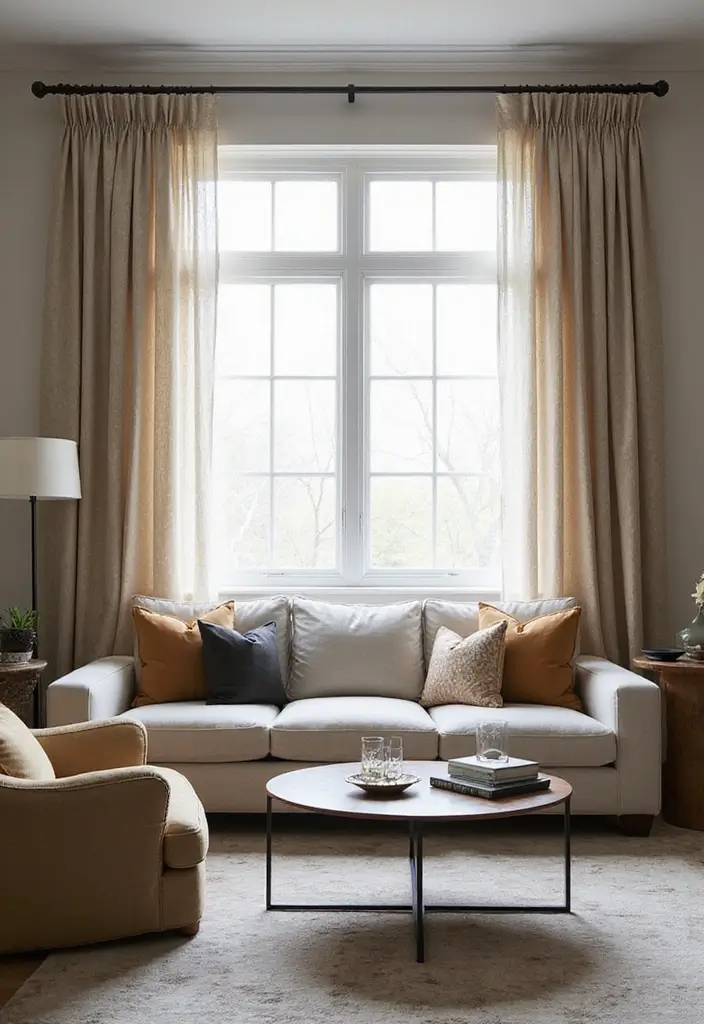
Want your apartment windows to feel bigger and more stylish while keeping light just right? Layered window treatments do this work.
Start with sheer curtains. They soften harsh sun and let in a gentle glow.
Add heavier drapes. They give privacy and frame the view cleanly.
When you pull them closed, the room feels snug. When you open them, you gain brightness and a sense of space.
Mix textures with linen, cotton, or velvet. Pick colors that match your walls and furniture for a cohesive look.
Here is why this works: layered panels add depth. Your eye travels from the frame to the folds of fabric, which makes the window look larger. You also get practical light control. Sheers glow in daylight; heavy drapes block glare at movie time.
Suggestions:
Next steps.
– Install curtain rods that extend past the window for a wider, airy feel.
– Choose adjustable blinds or a track system to tune light quickly.
– Play with patterns and textures to add character without clutter.
Layered window treatments give a refined look that balances style and function. They are a great choice for any 2-bedroom apartment.
25. Integrated Technology
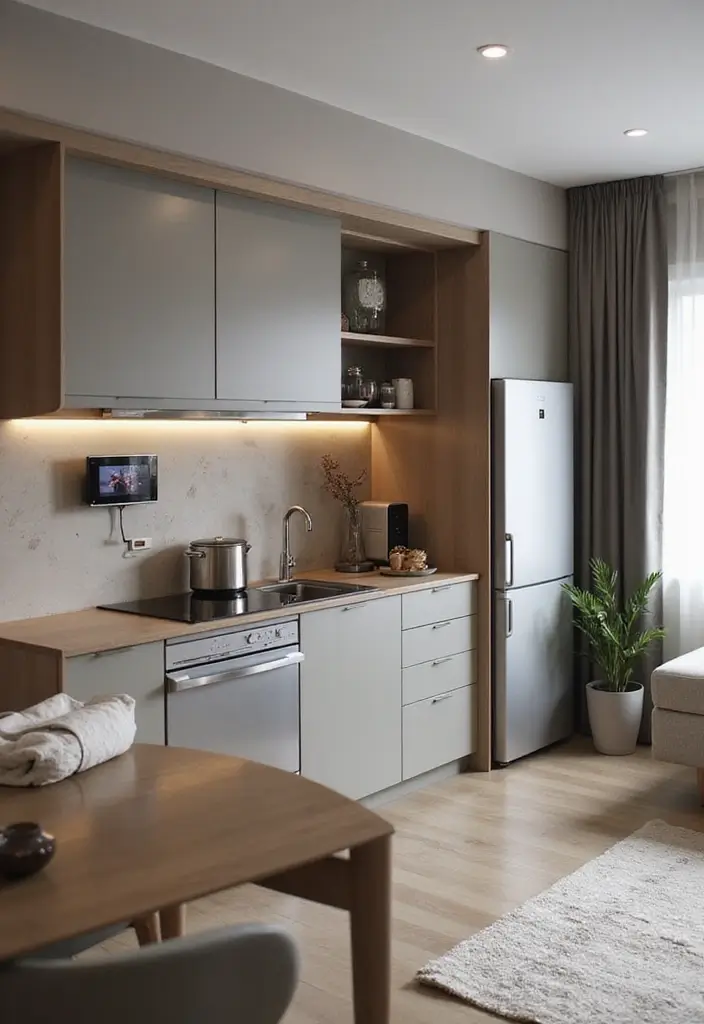
Living in a small two-bedroom space, you want tech that helps, not crowds your rooms. Pick gear that does two jobs and hides where it belongs. This space-saving tech fits small apartments and keeps life simple.
– Smart plugs and tidy power
Smart plugs let you control lamps and small devices from your phone or voice. Turn things on without getting up and keep outlets free. Schedule lights to wake you softly in the morning to start your day.
– Hidden charging docks
Create charging spots in shelves or under a cabinet. A phone or earbuds can rest there while charging. Cords stay tucked away and surfaces stay clean.
– Slim devices that fit your decor
Choose compact gadgets that match your room. Look for quiet fans, tiny speakers, or slim cameras that blend in.
Smart lighting is quick and neat. Use wireless bulbs or strip lights along a shelf or under cabinets. They add color and mood with a tiny footprint. Control them from a phone or a small switch.
Next, built-in power in furniture makes a real difference. Look for tables or desks with USB ports or a hidden power strip. It keeps cords out of sight and makes a space calmer.
Here is why this works. It makes daily life smoother and looks neat. Start small: pick a plug, a light, or a dock, and see how your space changes. Give it a week and you will feel the space breathe.
26. Unique Shelving Solutions
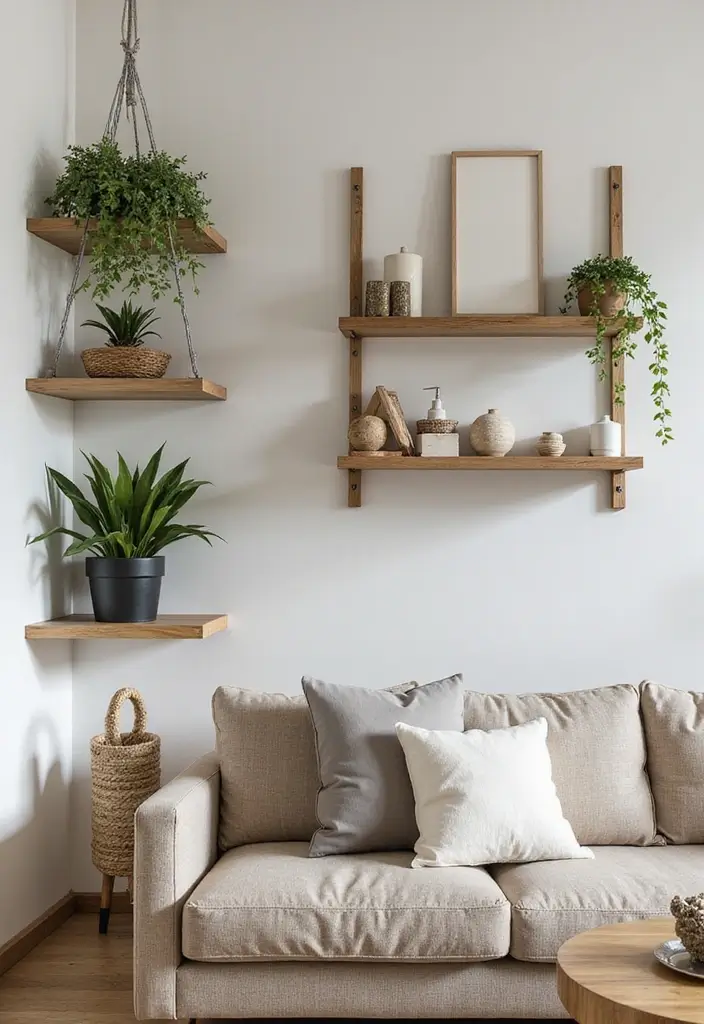
You want storage that clears the floor and keeps your space calm. Shelving can do that and add style at the same time. Here is why corner shelves, ladder shelves, and modular units fit a small apartment.
– Corner shelves: They sit in tight corners and save space. You can stack plants, books, and keepsakes without crowding the room. Choose open shelves with a light finish to keep the area bright.
– Ladder shelves: Leaning shelves bring height and texture. They work well beside a sofa or desk and leave floor space open. Use small baskets and pots to tame clutter and add color.
– Modular shelving: Build a unit that fits your wall and needs. You can add or remove sections as your life changes. Pick materials like pine, metal, or a warm wood tone to match your style.
– Shelves that double as dividers: In open plans, slim bookcases or open racks can separate zones without closing them off. Place LEDs above or along the edges to highlight books and plants.
Tips:
– Mix shelf heights for an eclectic look.
– Add lighting above or around shelves for a soft glow.
– Let shelves hold books, plants, and favorite trinkets to show your personality.
These ideas give you practical storage while keeping your walls interesting.
27. Artistic Decor Elements
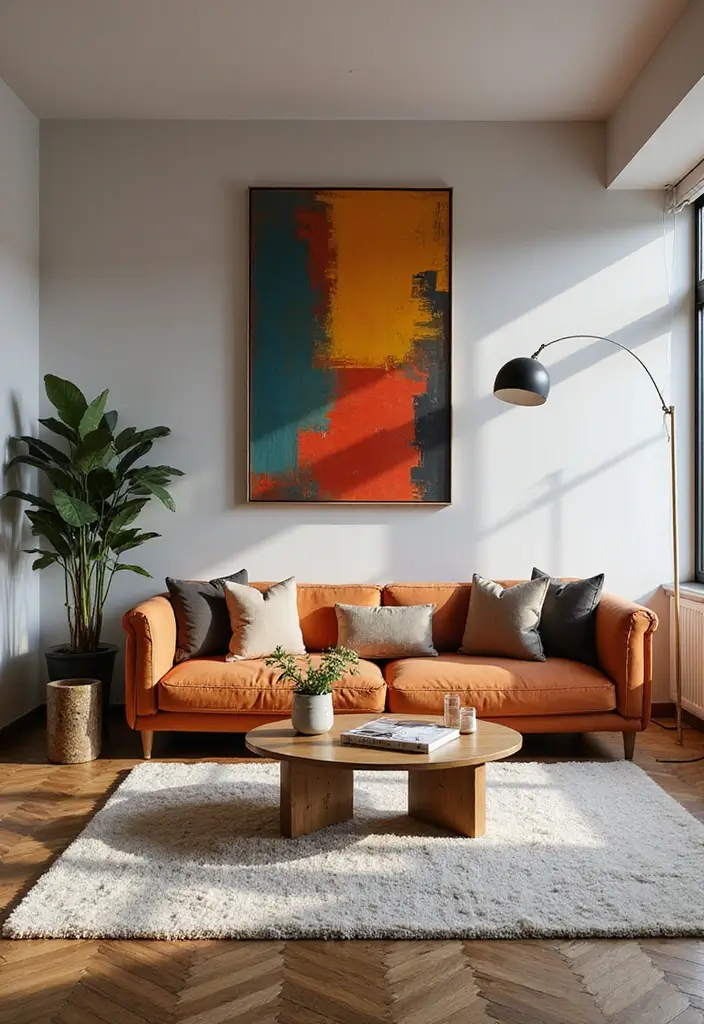
Here is why artistic decor matters in a two bedroom apartment. It adds character without adding clutter. A few bold pieces can guide the eye and make rooms feel cozier.
Art ideas to try
– Mix art types for texture. Pair a large centerpiece with a couple of smaller prints and a small sculpture.
– Hang at eye level. Center each piece about 57 inches from the floor for easy viewing.
– Create a gallery wall. Align several pieces in matching frames with even space between.
– Add color and texture with textiles. A bright throw, a woven wall hanging, or a silk cushion ties tones together.
– Light art well. Use a slim track light or a wall sconce to bring out colors in the evening.
– Rotate your picks. Swap pieces every few months to keep the space fresh.
Tips for success:
– Let a few bold tones stand out, but keep most hues from clashing with furniture.
– Keep borders clean. Give each piece room to breathe.
Common questions:
– Will art make a room feel smaller? The right big piece can anchor walls and feel open.
Next steps:
– Start with one piece you love, then add two or three smaller works to finish the look.
Your home will feel more personal.
28. Playful Patterns
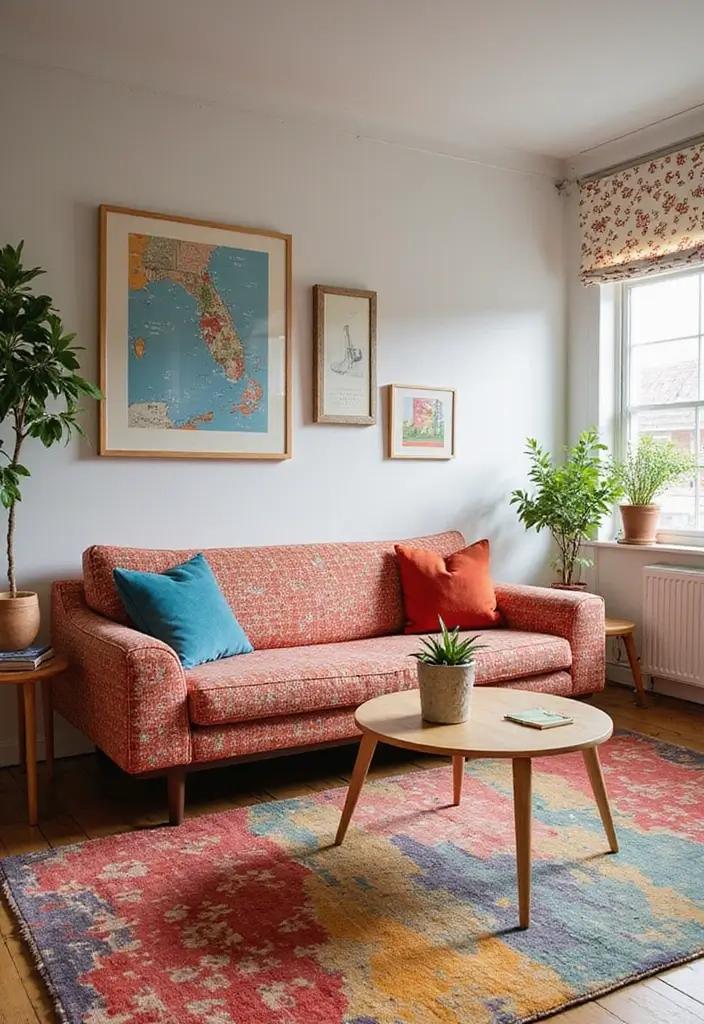
If you want your small apartment to feel lively and stylish, patterns are your friend. They wake up a space without shouting. You can bring them in with textiles, wall coverings, or simple décor items, and balance them with solid colors that calm the eye. Patterns add personality you can control.
Here is why they work in tight rooms: patterns create rhythm and guide your eye around the space. They give you a sense of order, even on a limited footprint. Let’s break it down with easy steps you can use today.
– Choose a focal wall for bold patterns – Pick one wall to carry the big print, like a geometric wallpaper or a large art panel. Keep other walls solid to let the pattern breathe.
– Mix patterns in accents – Layer patterns in cushions, throws, and small rugs. Repeat a shared color so the pieces feel connected rather than random.
– Keep colors in harmony – Tie the look to your existing sofa, curtains, and art. If the room feels busy, cool the palette with light neutrals.
Next steps: start small, then grow. Test with a single patterned item, then add one more pattern later. You’ll enjoy the depth without crowding the room.
29. Seasonal Decor Swaps
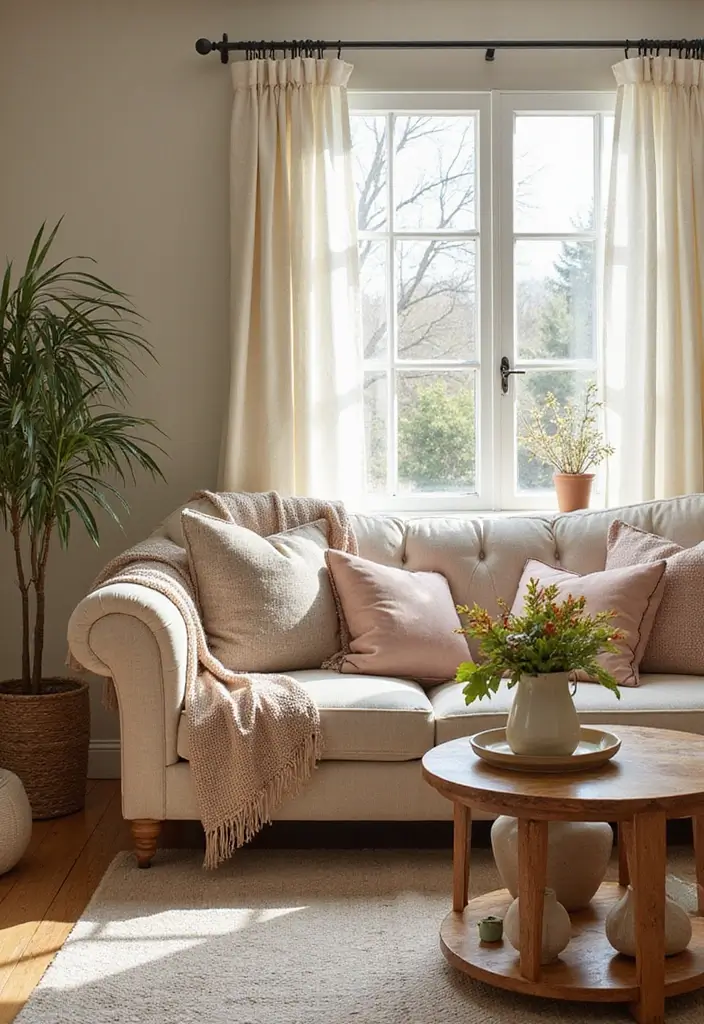
Seasonal swaps refresh a small apartment
Your space can feel flat after months of the same look. Seasonal decor swaps give you a fresh vibe with little work. They let you express your style without big renovations.
Seasonal swaps focus on textiles, colors, and small accents. Swap throws, pillows, curtains, and art to shift the mood in minutes. You’ll notice brighter corners and a cozier feel, with almost no clutter.
Here is why this works for small spaces. A few well-chosen pieces can make a room feel anew without moving a wall.
Here is how to do it\n\n
– Plan a seasonal color palette with 2-3 colors you love.\n
– Gather off-season textiles in labeled bins for quick swaps.\n
– Update art and wall prints to match the season.\n
– Add one seasonal accent, like a plant, a candle, or a fresh bouquet.\n
– Check lighting and swap in a warmer or cooler bulb to set the mood.
Storage and tips
Store off-season items neatly so you can pull them out fast.
– Use clear bins or boxes under the bed.\n
– Label each container so you know what sits where.\n
– Rotate textiles on a simple schedule, such as every month.
Next steps
Keep a small kit ready with a few favorite throws, a couple of wall prints, and one plant. At the start of each new season, swap in your chosen pieces and enjoy the quick, refreshing change.
A few seasonal decor swaps can turn your 2 bedroom apartment into a cozy retreat. Just changing textiles and accents can create a fresh vibe without the clutter!
30. Customizable Furniture
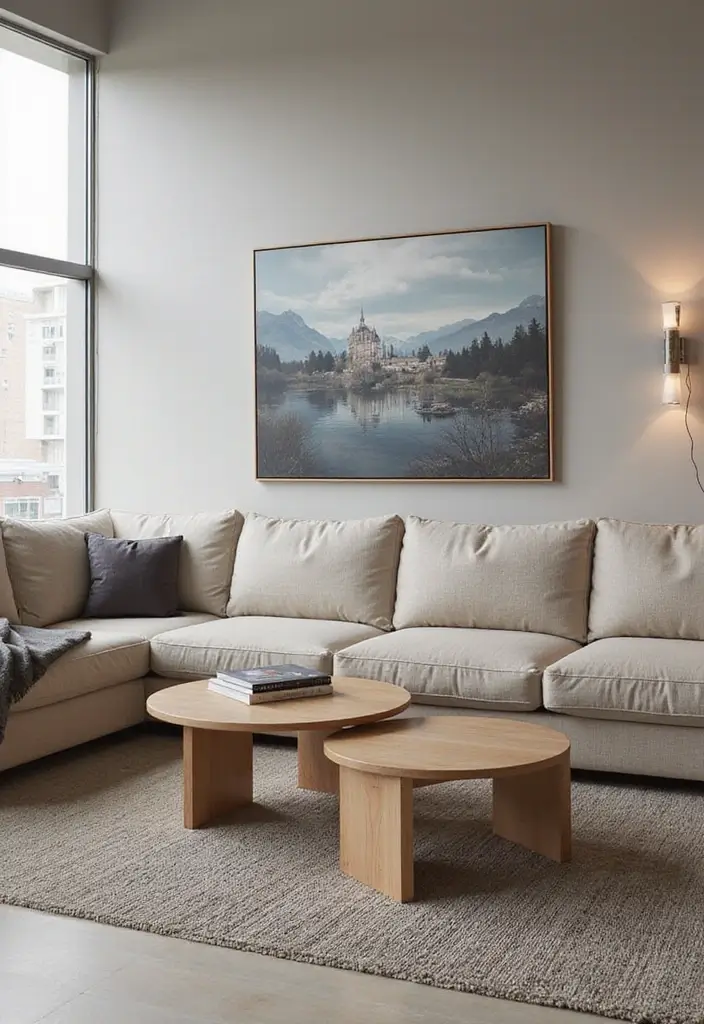
You want a 2 bedroom that feels roomy and stylish. Customizable furniture helps you get there. It adapts to how you live, so one piece can handle many jobs.
Here is why it works in a small space. Flexible pieces save floor space, cut clutter, and let you switch looks in minutes.
– Modular sofas you can rearrange. Pick sections you can move from a straight sofa to a corner setup. It comforts guests and fits tight living rooms. Choose fabrics that wipe clean easily.
– Nesting tables you can separate or combine. Use a small pair beside the sofa for drinks, then pull them together to make a bigger table when you host.
– Height‑adjustable tables and desks. Eat at the higher top, work at the lower, or lift the leaf for extra room during crafts. It acts like two pieces in one.
– Storage that doubles as seating. Ottomans with hidden space or a bench with cubbies hide clutter and offer extra seating without crowding the room.
– Lightweight, durable materials. Think aluminum frames, thin wood veneers, or sturdy composites. These stay easy to move and look clean longer.
– Light colors and simple fabrics. Pale tones make rooms feel open. Swap a slipcover or add a throw to refresh the vibe without buying new furniture.
Next steps: measure your spaces, pick a core flexible piece, then add one or two supporting elements. Test the layout, live with it a week, and adjust as your life changes.
Conclusion
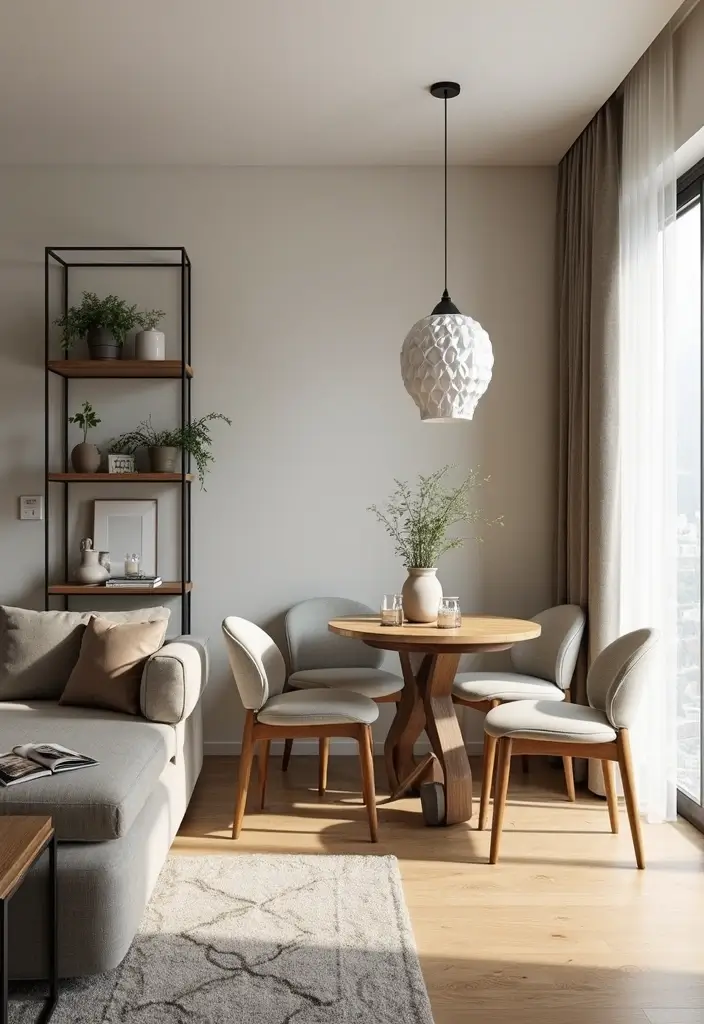
Living in a small space doesn’t mean compromising on style or comfort. With thoughtful design choices and functional furniture, you can create a welcoming home that feels expansive and chic. From clever storage solutions to personalized decor, each idea can elevate your 2-bedroom apartment into a stylish retreat. Embrace the possibilities and let your creativity shine as you transform your living space!
Frequently Asked Questions
How Can I Make My 2 Bedroom Apartment Feel More Spacious?
To create a more spacious feel in your 2 bedroom apartment, consider utilizing an open layout that combines living and dining areas. Incorporate multifunctional furniture, like a sofa bed or storage ottoman, which allows you to maximize space while maintaining style. Additionally, using light colors on walls and furniture can help reflect light and create an airy atmosphere.
What Are Some Smart Storage Solutions for Small Spaces?
In a small apartment, clever storage solutions can make a world of difference. Think about using under-bed storage or wall-mounted shelves to keep items off the floor. You can also explore over-the-door organizers for shoes or cleaning supplies, and consider investing in built-in cabinets that blend seamlessly with your decor to optimize every inch of your space.
How Can I Use Lighting to Make My Apartment Feel Bigger?
Lighting plays a crucial role in how spacious your apartment feels. Aim for layered lighting that includes ambient, task, and accent lighting. Use sheer curtains to allow natural light in, and consider adding floor lamps or wall sconces to brighten dark corners. This will enhance the open feel of your 2 bedroom apartment, making it both functional and inviting.
What Are Some Minimalist Decor Tips for a 2 Bedroom Apartment?
Embracing a minimalist decor style can help your 2 bedroom apartment appear more spacious and serene. Focus on essential furniture pieces that serve multiple purposes, and choose a few statement items instead of cluttering surfaces. Keep your color palette neutral and consistent, and incorporate textured accents for depth without overwhelming the space. This approach promotes clarity and a sense of calm.
How Can I Create Zones in My Small Apartment Without Closing Off Space?
Creating distinct zones in a small apartment can be achieved with stylish room dividers or furniture arrangements. Use a bookshelf or a decorative screen to separate living and sleeping areas without closing off the space. Opt for open shelving that allows light to flow while still providing separation. This clever design choice enhances both functionality and style in your 2 bedroom apartment.
Related Topics
2 bedroom apartment ideas
small space decor
multifunctional furniture
minimalist home decor
stylish furniture arrangements
maximizing storage
open layout design
layered lighting
creative use of vertical space
outdoor-inspired decor
customizable furniture
smart storage solutions

